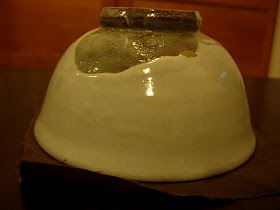
The Sam Do Style, or Three Island Style of tea bowl has a long history in Korea. The Rae Bin Sam Do style can be traced all the way back to the early 1400s and is one of Koreas classical styles. Like the Hwa Sam Do style and Ju Sam Do Style it has a very distinct look, or cannon, that is followed. Essentially they are trying to replicate the essence of a traditional bowl with only subtleties of each potter coming out in the final product. The idea is that the harmony of the elements, of nature, of the earth & fire is what is admired in the final product. The potter is below or under his product- the bowl his hands helped create. Of course, we cannot talk of this bowl without mention of Master Chon Han Bong- he is a brilliant potter and one of Korea's true masters.

This beautiful white slipped Rae Bin Sam Do style bowl is winter in feel while hinting at spring. So today, as winter rains fall and spring around the corner, it seems like the perfect day to examine such a wonderful piece.


The focal point of Rae Bin Sam Do style bowls is most definitely the calligraphy in the bowl's pool. The whole bowl seems to emanate around this centering feature like the island that this style of bowl was thought to come from. Here in the center we can also see the colour undernieth. It is the earth, the earth of the island. Its boundary is well defined by a white circle. From this calligraphy, from this white circle, the energy of the bowl is transmitted.

Squiggly lines emit from the center covered in a thin white that is blotchy, not completely covering the colours beneath. These squiggly lines represent the water, the waves that surround the island, the waves of peace that undulate in rhythmic motion that put us at ease when drinking tea from its innards.

The squiggles reach outward to the rim that is marked by notches, often a defining feature of the Sam Do Style. These notches are to thought to fill space with that which is beautiful but not pretentious. The notches that collar the inside rim on this bowl remind us to fill our lives with that which is beautiful but not to be braggarts, flamboyant, or pretentious but rather modest- happy with the simple things we fill our life with.

Of note on the inside rip is a finger print, a blotch, a human touch. Often blotches connect us to the human element of a tea bowl besides adding a measure of asymmetrical beauty. This blotch is especially beautiful and done quite tastefully.




The outside of the bowl is coated in a thicker application of white. Only when you flip the bowl over to admire its foot can you get a real feel for the contrast the white slip gives to the bowl. You also notice the ghostly layers white with thinner application in some areas and thicker in others where it coagulated then drizzled down the side. As the white nears the foot it thins into natural patterns with blotches of the base, green/blue brown colouring, showing through. These blotches add a relaxing element to the piece like watching a slow moving cloud in the sky.

The chop to is tactfully balanced with a small uncovered patch, revealing the clay below. It suggests modesty of the potter. The balance it creates with the chop is quite breathtaking especially with a such a thick layer of white defining its perimeter.

The division and contrast created by the distinct white boarder that cuts the foot in half is stark and is the focal point of the bowls bottom. Staring at its division reminds us of the division between Heaven and Earth. The sky, water, and island. The yin and the yang. The Dao.
Peace
Thank you for this deep and honoring discussion of the symbolism and artisan touches of this particular style of tea ware. I am enriched by it :) I'm curious though -- what is the meaning of the central calligraphy figure in the bottom?
ReplyDeleteOne more question, if I may -- why "three island"? Is that the name of where this style of bowl is thought to originate from?
ReplyDeleteLearning To Pull Radishes,
ReplyDeleteAlthough the calligraphy is the focal point and the defining feature of the Rae Bin Subtype, one has no idea what it says or what it is supposed to mean. The Korean owner of this bowl and his knowledgeable friends also didn't know because it is in classical Chinese calligraphy.
One suspects that it may be the location of the kiln but, this is only an educated guess.
If there are any readers who can translate, that would be great!
The meaning of "Sam Do" or "Three Islands" can be found here:
http://mattchasblog.blogspot.com/2009/04/sam-do-tea-bowl-style.html
Peace
Hi Matt,
ReplyDeleteyou should work for some museum or galery (if you already don't do that):) - your posts are pleasant to read, edifying and relaxed.
best
Petr
Petr,
ReplyDeleteThis is the gallery.
Tea is the art.
Peace